Mycelium vs fruiting body. Which is better?
This debate is the foundation of much discussion in the medicinal mushroom community. The answer to which is better lies in a wealth of gray area. In this article, we aim to provide an unbiased perspective on this topic by helping you to understand the mushroom life cycle.
The power of medicinal mushrooms
If you’re interested in harnessing the powers of medicinal mushrooms, it’s important to understand the evolution of them. Understanding the mushroom growth cycle can help you interpret what products are on the market and which ones may have the highest medicinal value.
Medicinal mushrooms may be “new” to the average consumer, but they’ve been used for centuries, primarily in Eastern cultures. They’ve been a staple in Traditional Chinese Medicine, and recently, their global popularity has grown exponentially as consumers look to find supplements that may help support everything from immunity, cognition (brain health), focus, heart health, stress relief, and sleep, to more severe medical conditions like Alzheimer’s, depression and cancer.
There seems to be a species of mushroom for just about any condition out there and more research continues to be done to understand the efficacy that each mushroom has.
So, while it’s clear why more people are flooding into the market, it’s important to be educated in the various product types before doing so. The last thing you want to buy is a product that isn’t all it’s hyped up to be!
The goal of this article is to help you understand the entire mushroom life cycle and why some products may be better suited for functional applications than others based on where they are harvested in the growth cycle.
Let’s get into it.
The mushroom life cycle
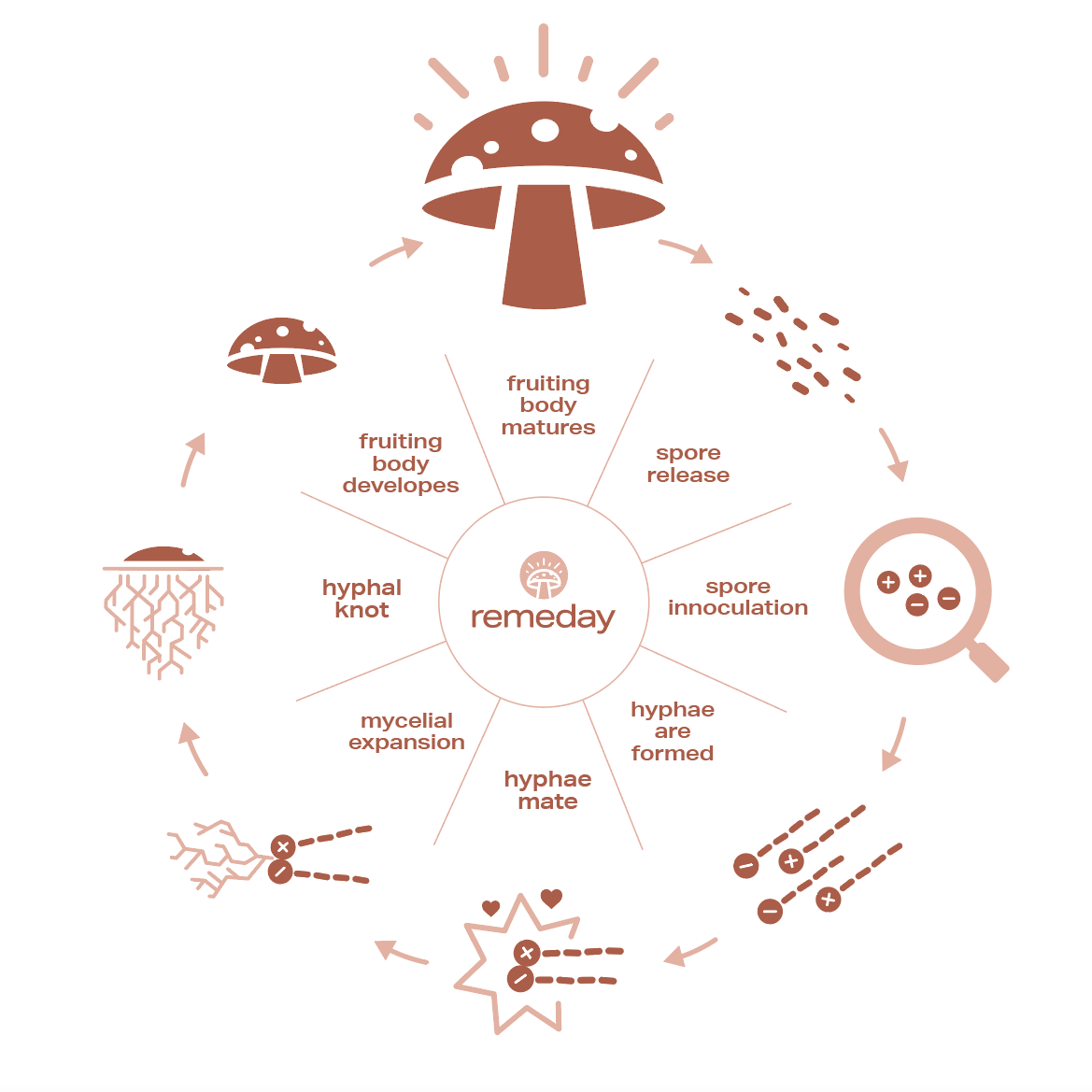
For a long time, mushrooms and other fungi were grouped into the plant phylum. It wasn’t until 1969 that fungi became their own kingdom.
Without mushrooms, plants wouldn’t be able to survive. It’s truly fascinating how they work. Mushrooms act like a filter: they break down waste and recycle beneficial nutrients back into the earth.
Their growth cycle is extremely interesting, too.
Here’s how the mushroom life cycle works:
1. Spores
Mushrooms don’t have seeds like plants. They release spores. Spores are the reproductive cells of fungi. For illustrative purposes, you can think of spores as the seeds. These spores are released from the gills underneath the cap of the mushroom. A single mushroom can produce hundreds of thousands of spores!
2. Spore Germination
There are both male and female spores. After release, the spores will germinate with a spore of the opposite sex. Once they germinate, they create hyphae.
3. Hyphae
This is when groups of the same spore come together. Hyphae looks like a feathery strand or filament. Eventually, hyphae of different spores combine. When this happens, it’s known as the mycelium.
4. Mycelium
You’ll hear this word a lot when searching for mushroom products. Mycelium is everywhere. It’s the web-like root system of mushrooms that continuously branches out. If you were in the woods, and saw some mushrooms on the ground and decided to dig up a little bit of soil anywhere near it, you’d be able to easily spot it. The mycelium is the foundation upon which the mushrooms grow. It begins to colonize and spread, absorbing rich nutrients from its substrate.
5. Hyphal Knot
This is often referred to as the first stage of the mushroom fruit body. When hyphae strands begin to come together and bundle, the hyphal knot is created. If you’re growing your own mushrooms, you’ll start to see little bumps growing on the surface of the mycelium.
6. Primordia
When those little bumps start to grow and expand, they begin to look like miniature or “baby mushrooms”. This is primordia, which is often referred to as “pins” by cultivators.
7. Fruiting body
As these pins continue to grow and develop, they mature into the fruiting body of the mushroom. The fruiting body is the stalk and the cap of the mushroom that you’re likely the most familiar with, because you see it. It’s what you would be able to visually identify in the wild and also what you would purchase in grocery stores.
8. Repeat
And then, the growth cycle repeats itself once again as spores are released from the gills underneath the cap.
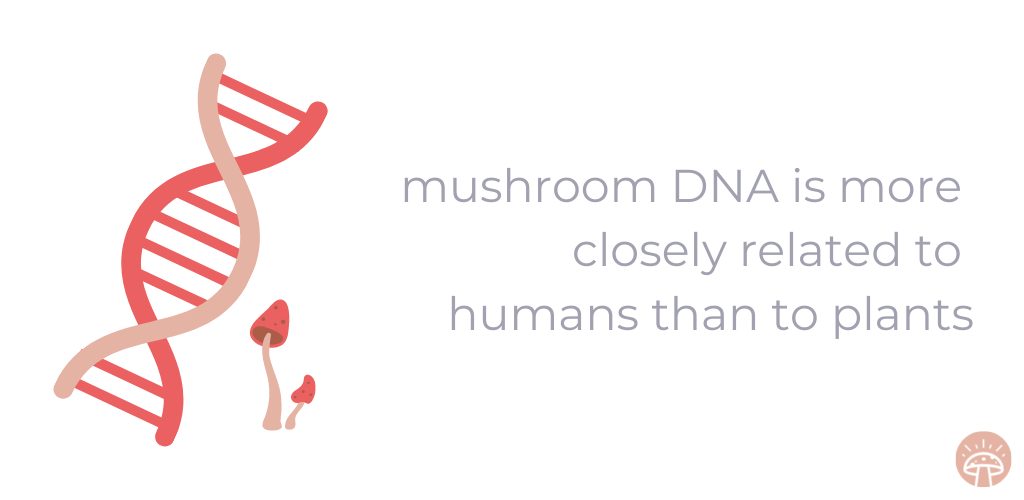
If you've gotten this far and those very science-y words are making your head spin -- no worries! Check out our Mushrooms 101: Mushroom Terminology to Know blog, and then come back to this one to keep reading.
Why knowing the mushroom life cycle is important when buying mushroom products
Understanding the life cycle of mushrooms helps to give a better understanding of what products are selling and how effective they might be.
You’ll likely see products selling:
- Fruiting body
- Mycelium
- Whole Mushroom/Full Spectrum - These are marketing terms which usually represent a combination of both fruiting body & mycelium
There is a lot of debate in the mushroom industry on which “part” of the mushroom should be used to get the most beneficial properties.
But, if you’re a mushroom enthusiast and an advocate for what they can do, you’ll realize that both parts have powerful potential benefits.
It all comes down to the cultivation practice.
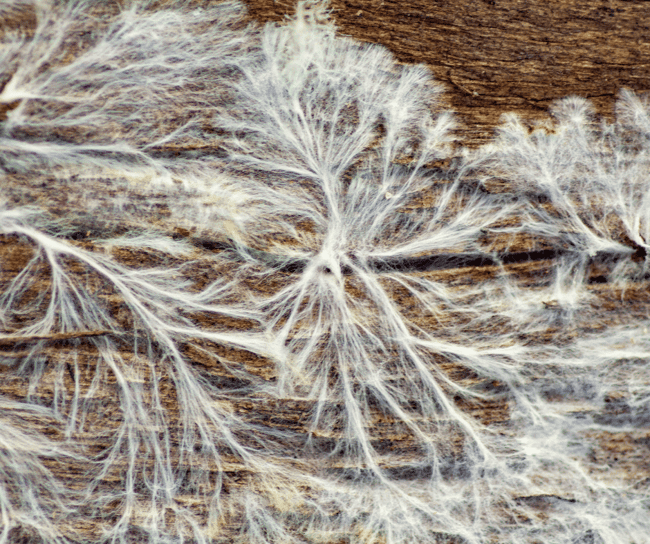 mushroom mycelium
mushroom mycelium
After understanding the growth cycle of mushrooms, one can firmly admit that fully developed fruiting bodies signify that the mushroom has reached its full maturity. Mycelium development happens very early in the growth cycle. That’s why many products like to promote that they only use fruiting body - because they’re selling a fully mature product.
However, there have been some studies, including this one, that are focused on the mycelium of certain species, stating that they do have the potential for antioxidant activity.
Another one was done on the mycelium of Trametes versicolor (turkey tail). It was said that both the mycelium and the fermented substrate it was grown on “each show potent and complementary immune activating properties in vitro”.
However, there was no standard of comparison, as in, they did not use the fruiting body to compare efficiencies.
There are two primary issues in the medicinal mushroom industry right now:
- Lack of in-depth research to explore ALL parts of the growth cycle and their unique or combined benefits
- Consumer product companies are looking to rapidly grab their share of the market without considering the science
Fruiting bodies have been studied more thoroughly and their potential benefits have been identified, to a degree.
Mycelium has been studied, in part, but with little controls done in those studies.
And that issue overlaps with the consumer product companies in the industry.
The issue with mycelium-based mushroom products
There is no doubt that mycelium has potential benefits. It’s a fascinating part of the growth cycle. It’s not enough to say that all mycelium-based products are bad. Some companies grow and harvest mycelium thoughtfully and sustainably.
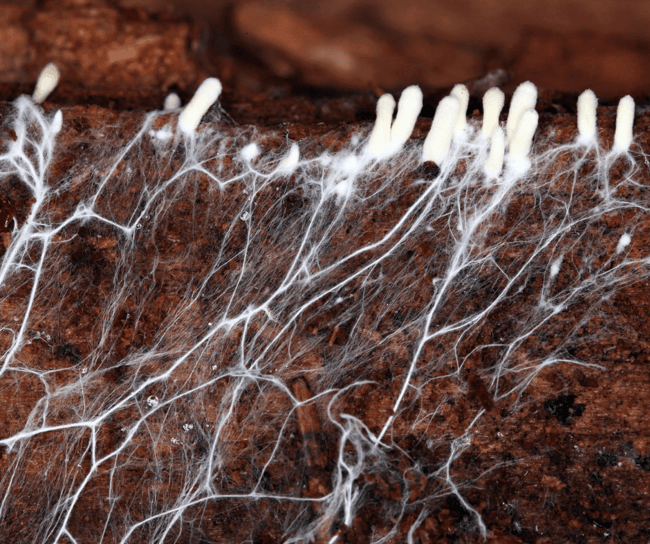 mycelium and small fruiting body caps
mycelium and small fruiting body caps
But there is significant cause for caution when purchasing mycelium-based products. More and more companies are marketing their products as ‘mushroom’ products, when in fact, they are simply mycelium grown on grain/rice/oats. Some companies are proud of their 100% mycelium production. While others loudly state they use both mycelium and the fruiting body.
NOTE: You might see the marketing terms: “full spectrum” or “whole mushroom” when they use both mycelium and fruiting body.
The problem with 100% mycelium products is that they typically harvest the mycelium off of one of those grain substrates.
Without proper care and extraction, a lot of that grain substrate can carry over to your product. When that happens, instead of buying a product you think is packed full of the nutritional and medicinal value of mushrooms, you’re really just getting the starch from fillers of oats, rice, or grain.
100% mycelium products are entirely missing out on the potential benefits of the fruiting body - where most studies have been done.
If the company says they’re using both mycelium AND fruiting body, they rarely, if ever, specify how much fruiting body they are using to make their product. They also fail to specify at what stage they harvest the fruiting body. Some might see a tiny mushroom cap and call it the fruiting body. That’s misleading.
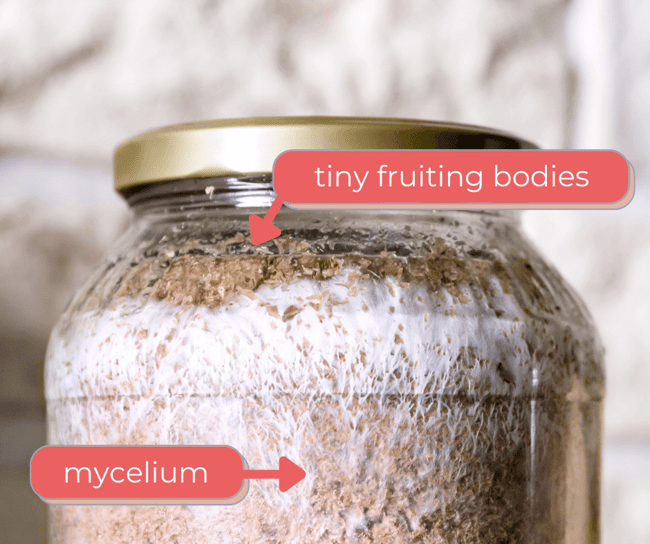 companies could technically sell this product as 'full spectrum' despite lack of full growth
companies could technically sell this product as 'full spectrum' despite lack of full growth
Many educated mushroom consumers assume that companies who are using ‘full spectrum’ or ‘whole mushroom’ messaging are primarily using the mycelium - unless they share details on their growth methods and can show lab test results of all the active compounds, like beta-glucans and terpenoids.
Full-spectrum companies oftentimes only allow the mycelium to grow for a short period, which really doesn’t allow the mushroom to grow to full maturity or have any fruiting body at all. They may just be waiting for the small hyphal knot to appear, and then say “that’s fruiting body”, because that’s generally regarded as the first stage of the mushroom fruit body.
But as you can see by the growth cycle diagram and the jar example above, a hyphal knot or small cap is nowhere near full maturity.
A NOTE ON FULL-SPECTRUM PRODUCTS: Some full-spectrum companies don’t allow the fruiting body to mature. It takes time, money, resources, and energy to grow a fully-developed fruiting body. That impacts the company’s bottom line. More expensive doesn’t necessarily mean better quality. But be wary of very cheap products stating they include fruiting body. It could mean that the company is using very little or highly-underdeveloped fruiting bodies.
Could these products have some nutritional and functional value? Absolutely. But if you’re purchasing a product, especially for functional applications, it’s critical to understand exactly what you’re buying. Especially if you’re hoping to use medicinal mushrooms for a specific treatment plan.
Why do so many companies use mycelium-based products?
The United States does not currently have the infrastructure to grow fruiting body mushrooms at a massive scale. To match China’s output would likely cost billions of dollars. Mycelium is relatively easy to grow and harvest. It can be done in large quantities and at a low cost. Some mycelium is grown in enormous sugar water vats and extracted from there. So be careful if you’re buying a mass-produced US-based mushroom product that costs less than an international one. It may not have been grown thoughtfully. That’s not to say that all mycelium products are bad. You just need to do your research.
Mycelium vs fruiting body - which should you choose?
It all comes down to transparency. Until there is more regulation in the market, 100% fruiting body products are going to be the primary product you’ll want to look for. But even still, these companies should be able to provide a COA and independent test results that showcase safety tests (microbial levels, heavy metals) and detail the beta-glucan percentage and terpenoids.
These will vary by species, but it will give you the information you need to make an informed decision.
The supplement company should also freely share their growing, harvesting, and extraction methods without preaching to you about why other methods are bad. This is unfortunately a very common response for a lot of prominent supplement consumer brands.
The same goes for products that use fruiting body and mycelium. Are they open about their harvesting practices? Can they speak to their cultivation method? Do they provide lab tests? How much fruiting body do they use? At what stage in the growth cycle do they harvest the fruiting body?
That is the best way to determine a reputable product from one that misses the mark in terms of quality and effectiveness. Sometimes, your best products will be from local farms and advocates. The best marketing doesn’t always equal the best product.
No two mushroom products are the same and it pays to do your research.
Depending on what you’re looking for, you can skim through our favorite companies and the products they offer in these blogs and more:

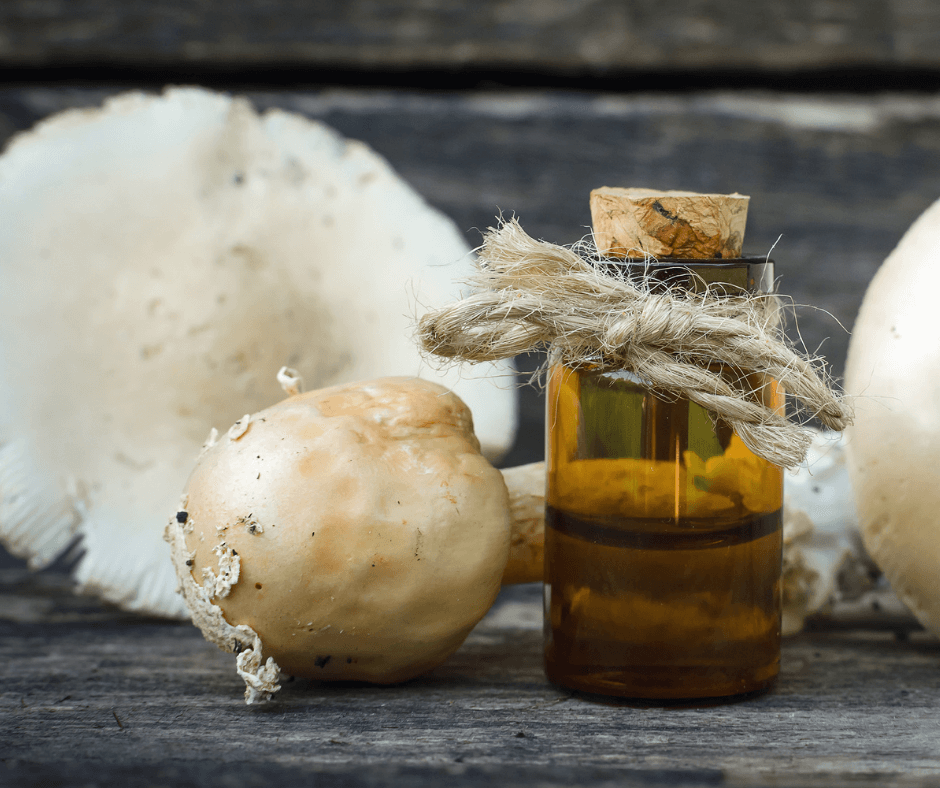
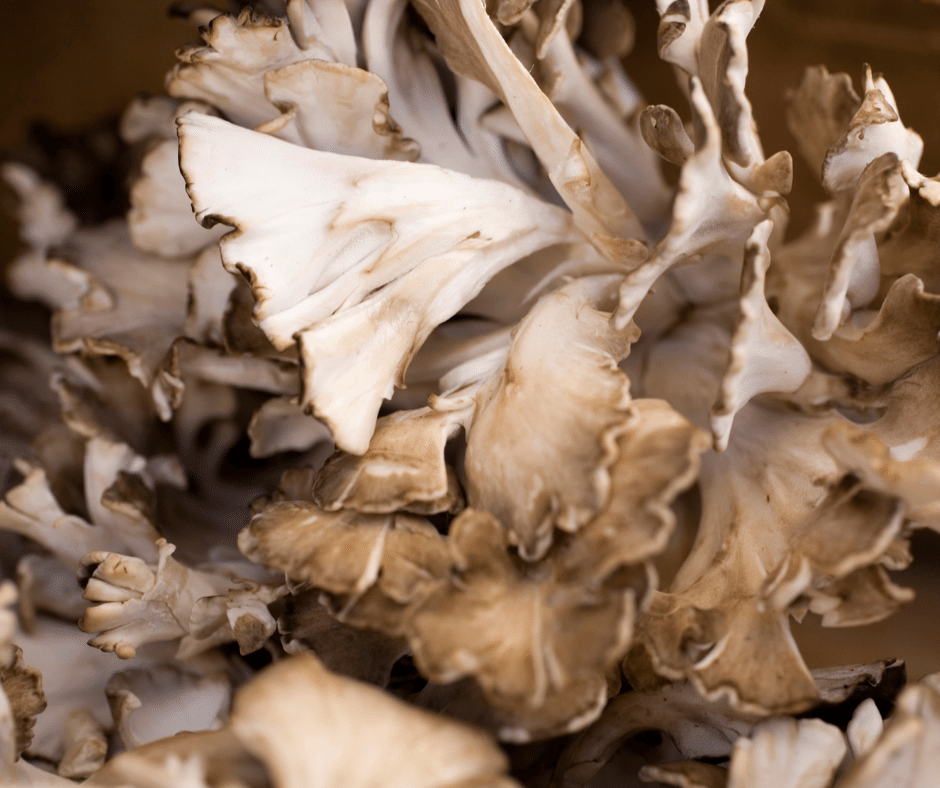


.png)
